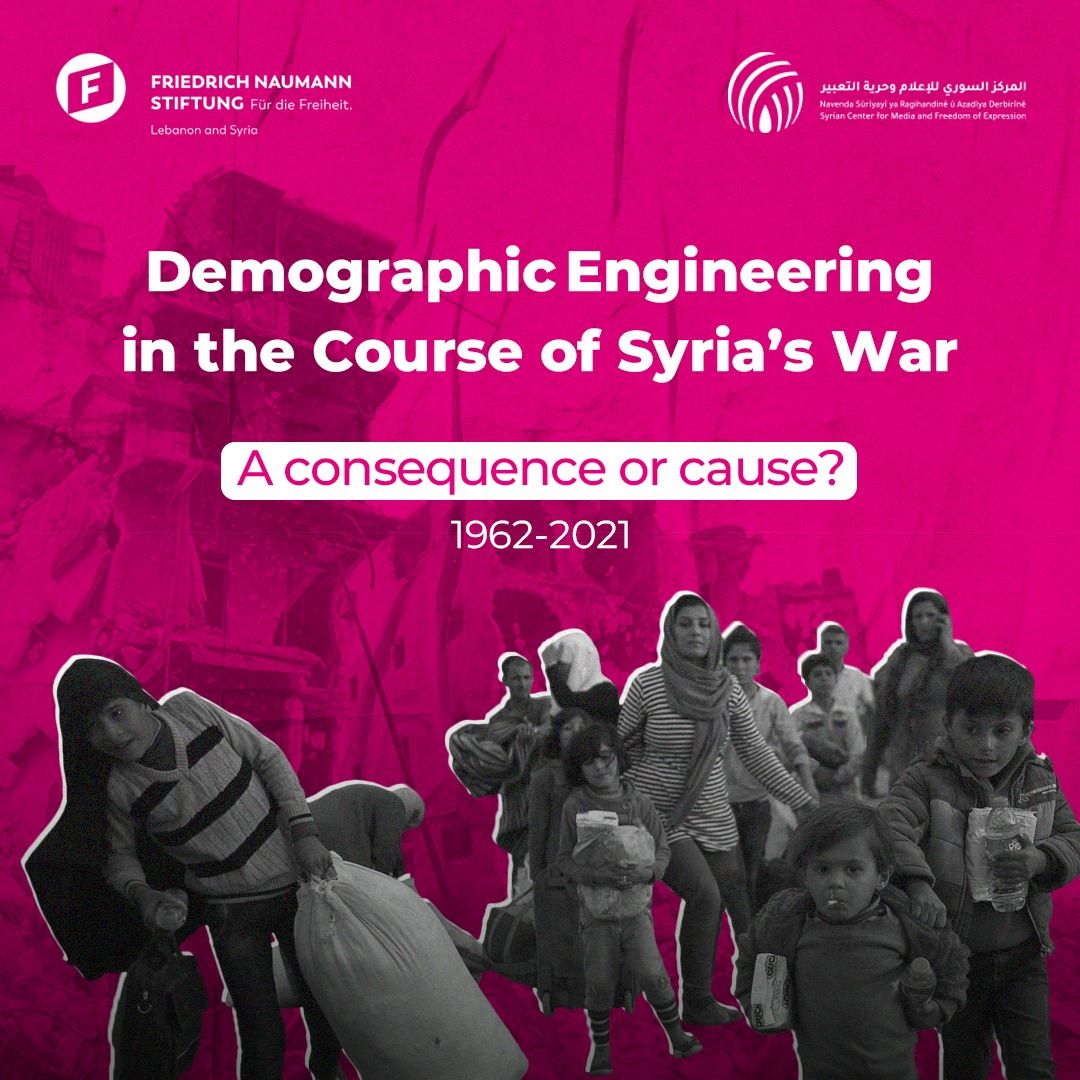Syria
Demographic Engineering in the Course of Syria’s War

Summary
“And whoever fled and ran away from Syria to any other country, please do not come back, because if the state forgives you, we promise you that we will not forget and we will not forgive.”
Brigadier General Issam Zahreddin in an interview with Al-Ikhbariya Al-Suriye channel in September 2017
Since the Syrian conflict started a decade ago, three-in-five Syrians fled their homes, some of which were forced to flee more than once. Sixty percent of the population or fourteen million have been displaced and stranded inside the country or turned into refugees. As for the urban destruction, the World Bank estimated in its presser “The Visible Impacts of the Syrian War May Only be the Tip of the Iceberg” that about a third of the housing stock and about half of medical and education facilities were completely or partially destroyed as of 2017.
The 70-page report “Demographic Engineering in the Course of Syria’s War: A consequence or cause?" analyses the processes of population displacement and urban destruction in the context of the deliberate change of the demographic structure in Syria, from the perspective of demographic engineering.
Most research studies focus on the Syrian regime’s bombardment and destruction of residential areas, as well as on its use of indiscriminate bombardment as a systematic policy in urban areas, in order to stress the regime’s war crimes. Such studies suppose that the Assad regime’s war tactics and practices are primarily deployed for military reasons and with the purpose of achieving military victory, at all costs, including war crimes. More generally, they aim to evoke the systematic and indiscriminate bombardment policy as a basis for criminalising the Syrian government for war crimes and crimes against humanity.
However, shedding light on the government's intent behind the mass destruction of civilian objects does not serve to reveal the plot of demographic engineering that is being widely conducted.
The government’s post-destruction policies in devastated areas, including what it calls reconstruction and what we explain in detail in this report as a continuation of urbicide, showcases how the Syrian government is committing discriminatory demographic engineering to consolidate its control at the expense of the population. This report highlights the latter by analysing and revealing the link between the locations of the previous and recent organisational plans and the areas of destruction and demolition since 2011. The report also analyses the relation between the organisational plans before and after 2011 and the destroyed areas after 2011. It argues that whether the relation was a correlation or causation, it is how the Syrian regime acts after the destruction that eliminates the need to prove the regime’s implementation of discriminatory demographic engineering.
Whether the main intention of the mass bombardment of cities and towns was to achieve military victory or was a part of a demographic engineering scheme, what the government does after the destruction is what determines the completion of the crime of discriminatory demographic engineering. In both cases, the government has exploited and benefited from the defacto situation resulting from the crime of forced deportation to complete demographic engineering schemes; and therefore, it is considered responsible for it, if it does not attempt to restore rights to their owners and put property rights as the basis and a condition for any construction and reconstruction operations.
The research traces the paths of demographic change prior to and during the conflict and defines modern concepts of demographic engineering and urbicide in Syria.
The report does not address the natural causes of demographic change, such as births, natural migration to and/or from cities, climatic causes, etc., but focuses on deliberate efforts for demographic change, that is, demographic engineering. The report also highlights the role of political, religious, racial and mixed attitudes that were used as motives and tools for displacement and for committing atrocities that forced residents to leave their homes and areas.
In its first chapter, the report expands on the definition of the concepts of demographic engineering and urbicide, as they are relatively recent concepts with varied definitions that are not defined in authoritative sources of international law. Both concepts provide a broad gate to understanding and analysing events in Syria, including forced displacement and urban destruction. The report tries to place urbicide within the framework of international law and sets the first steps and initial perceptions of these terms in the Syrian context.
In its second chapter, the report examines the practices of demographic engineering in Syria before the start of the popular protests and the conflict in 2011 and analyses its impact as one of their main drivers.
In its third and last chapter, the report reviews the major incidents of demographic engineering in Syria with the start of the Syrian revolution in March 2011, which were documented by the Violations Documentation Centre in Syria and compiled by its monitoring team. It included incidents by the Syrian government, Iran and its militias, the Kurdish Autonomous Administration, the Syrian opposition, and the Turkish occupation.
The report concludes with recommendations to the belligerents of the conflict, the international community, and other stakeholders.
Download the full report in English or Arabic here: